Plate 77.....................
The search for penny plate 77 1d reds ( Catalogued by Stanley Gibbons G1 - SG43/44) has probably caused more disappointment to stamp collectors and philatelists than any other stamp over the last century and certainly continues to do so. Fakes, blurred inks, obscuring postmarks, optimism and inexplicable oddities all make the search for a genuine plate 77 stamp a hard one.
One thing seems sure and that is that some stamps must have been printed from plate 77 even though it was never registered. Usually at least one sheet was printed from a new plate and then sent to Somerset House for approval before the new plate was put to press. When approved, one sheet was kept there as the registration, or imprimatur sheet as it is often known. Any faulty sheets would then have been destroyed by burning at Somerset House and any good ones put into stock in the normal way. Wright and Creeke assert in "The Stamps of the British Isles" that up until 1899 the printers struck off 6 trial sheets of which one chosen as an "imprimatur" and the others put into stock and then issued. It is also worth noting that prior to these example sheets being printed it is certain that some others would have been printed as part of the process of setting up the printing press with a new plate. So, any example sheets examined should have been returned to be first accounted for and then destroyed if faulty and issued if not, and in the case of plate 77 some stamps have survived. We know the plate must have reached the point of inspection because a letter from Ormond Hill to Perkins Bacon still exists, telling them that he was rejecting two plates as they were not vertically aligned well enough to allow a good standard of perforating and although this letter doesn't mention the plate numbers, they must have been plates 75 and 77 because the date of the letter (7th February 1863) is the same as the date on which the other plates submitted at the same time (76 and 78 to 81) were registered. Hill must have been looking at least one sheet produced from plate 77 (and from plate 75 too as it happens) to have made this decision - so at least one sheet from plate 77 existed at some point. The only alternative is that Hill determined that the plate was poorly aligned by looking at the plate itself but as that would have been so very much more difficult to do than the simpler and usual way of looking at an example sheet there is no reason to think that happened. After all, it is reasonable to assume that he would have wanted to make absolutely sure that plate 77 was unusable before rejecting another plate. We will never know how many copies of this stamp were printed from plate 77, maybe one sheet, maybe half a dozen sheets, but one thing is sure, it wasn't many! If the odd 77 has escaped into the wild then there is also the possibility that examples from plates 69, 70, 75, 126 and 128 may be found one day as well, but it's not likely. If they were going to be verified they probably would have been by now. As of now none are known to exist although in his book "The line-engraved postage stamps of Great Britain printed by Perkins, Bacon & Co.; a history of their production during the forty years, 1840-1880" Sir Edward Denny Bacon mentions that H L Estrange-Ewen had seen copies of both plate 70 and 77 stamps "evidently from proof sheets". Having said that, he also claimed that "entire sheets of 226, 227 & 228 exist with the surcharge "Cyprus"" but it is likely he was mistaken as those plates, although completed were not registered and there is no record of any stamps being printed from them. The printing plate for plate 77 stamps was defaced on 12th December 1864.
In an article in The Philatelic Record periodical of January 1895 W A S Westoby comments on some of "Lord Kingston's recent papers" as follows.
"What Lord Kingston means when he says that plate numbers have been discovered "in some cases of plates not known to exist" I fail to divine, unless reference is intended to plate 77 of the one penny, which is the only one that I know of, the existence of which cannot be clearly accounted for. But in the case of plate 77 the plate existed; it was refused registration because the impression showed that the stamps were unevenly laid down, and it was considered not properly adapted for perforation. It is clear, however, that an impression taken from it, though deemed defective, did not find its way into the spoilage, but was perforated at Somerset House. The same thing may also have occurred with plates 75, 126, and 128, which were also refused registration, two of them on similar grounds to plate 77, and the third that the punching was defective".
Also, Judge Philbrick stated that he had seen a copy of plate 70 (AA) in the "Stainforth collection". Reverend Francis John Stainforth was one of the early pioneers of stamp collecting and he is said by Bacon to have obtained the plate 70 stamp in 1858 although this date must be incorrect as the plate wasn't made until 1861. His collection was dispersed in early 1865 about 18 months prior to his death and the plate 70 stamp was bought by Judge Philbrick. It was then bought by Ferrary when he acquired Philbrick's collection in 1872. In 1891 Philbrick also stated that he had seen 2 used copies of plate 70 and Bacon states that "in 1898 another supposed copy was the subject of an action for the recovery of the stamp at the County Court of Sheerness". All very mysterious! On February 15th 1861 Ormond Hill wrote - "The heads in plate 70 are by no means accurately placed: but the inaccuracy is not so great but that we can manage to perforate impressions from it." Bacon write "Later on the plate was found to be defective and condemned". Fred Melville says in his book on GB line-engraved stamps that copies from plate 70 are known too.
Here is some more information relating to plate 77 which may be of interest. Firstly, I believe that 8 have been found so far, not 10 as mentioned in the July/August 2009 GBJ. 4 mint stamps and 4 used. Two of the mint stamps have been lost leaving 6 currently accepted examples of plate 77 in existence.
AA - The lettering is unconfirmed, but AA is the most likely position if the old tradition is accepted that a mint irregular block of 4 was discovered back in the 1870s (AB, AC and BA are known to exist) and split into individual stamps. AA is the logical missing stamp. In 1868 Judge Philbrick refers to a trial sheet of penny plates printed in 1863 an example of which lettered AA came into his possession. He said "It is finely printed in very red carmine. There is nothing to distinguish it as a proof and except from the source from which it came into our collection we should hardly have supposed it to be such". Bacon didn't know what plate it came from and said he thought it must have been a stamp from the "imprimatur" sheet. Now, could that stamp have been from plate 77?! "AA" or whatever stamp it was, was in the collection of William Hughes-Hughes who was one of the founder members of the Royal Philatelic Society London. He was a Barrister of the Inner Temple and his collection was started around 1859 and discontinued about 1874. When interviewed by the Stanley Gibbons Monthly Journal in January 1896 (when the stamp was bought from him by Gibbons as part of his "Great Collection") he stated that the whole collection had only cost him £69 as most of his stamps had been obtained "through influential connections". The article also mentions that all of the stamps are "stuck down tight and have to be cut out" so presumably this example would have been sold unused rather than mint! Although Bacon mentions this stamp as being in the Ferrary collection I can find no evidence of this (it didn't appear among the listed items sold at the Ferrary sales in Paris so maybe the example of plate 70 said to have been bought by him has been confused with a 77? In fact it was sold to stamp dealer Herbert L'Estrange Ewen who in turn sold it to Henry J Crocker in America (see The Philatelic Record June 1902 page 132) where it was lost in a fire that followed the San Francisco earthquake of 1906 so it's most unlikely that this stamp will ever reappear. I would be interested to hear if anyone has any references from American publications to do with this occurrence and any reference to the check letter position would be great! This stamp is also referred to in the 29th February 1908 issue of "The Postage Stamp" as follows - "Gibbons' catalogue after stating that a specimen of plate 77 is in the Tapling collection adds "and we have had a second". This second copy Mr Ewen in his Weekly Stamp News informs us was bought by him and sold to Mr HJ Crocker, being burnt along with the rest of the latters collection of British stamps in the San francisco collection. The Tapling copy is therefore unique." In the 28th March 1908 issue of "The Postage Stamp" Mr N V le Gallais points out that he has a used copy of Plate 77. He is referring to LL.
AB - Is an unused stamp now in the Royal Philatelic collection. Bacon refers to this stamp being in the Royal collection in 1919 after being acquired by King George V. It was bought from Bridger and Kay stamp dealers on 8th August 1918 for a price of £499 9 shillings. This sale is recorded in their original hand written sales ledger from 1918 but sadly does not record where they got the stamp from! The customer is listed as E D Bacon, Buckingham Palace SW1 who of course is Edward Denny Bacon the curator of the Royal Collection at that time. There are some gum residues on the stamp but there is no way of saying whether this is original gum. When viewed from the back the Large Crown watermark is very slightly high of centre and slightly left of centre. The top perforations are scissor-cut in a sloping fashion. It looks like a Type II large crown watermark but it's hard to tell for certain.
AC - It was found in 1919 by Chas Nissen (the discovery is recorded on the front page of The British Philatelist, October 1919, Volume XII Number 8). It is stated - "Our publishers have shewn us an unused copy from the very rare plate 77 of the old Red Penny. This is the fourth unused copy which has been discovered.....Mr E D Bacon stated "It is the same colour as the one in the Royal Collection which is lettered AB and the two stamps at one time formed a pair...I can tell this for certain, from the position the perforation occupies round the edges of the two stamps". Like AB, the top perforations are scissor-cut in a sloping fashion. This stamp was found at the same time as AB and although it is clearly recorded that Chas Nissen found AC it does not seem to be confirmed anywhere that he found AB too. Here is a first hand account from Tom Allen, who bought a great deal of material for the Royal Collection, and was asked to be Keeper Of The Royal Collection (by Wilson) when Wilson retired. He was one of the few dealers ever invited to join the RPS London, and was on their Expert Comitteee for over 20 years, 1954-1975. He wrote - "Over the years I purchased a great many stamps for the Royal Collection. One of my great friends was the late Charles Nissen, who was the only individual stamp dealer ever to be granted a Royal Warrant. One day I was in Charles' office when one of his assistants came in to say that a man outside had a mint Great Britain Plate 77 that he wished to sell. Almost all the so-called Plate 77 stamps are no more than 177 with the "1" more or less skilfully removed. The genuine stamp is extremely rare with very few copies known to exist. It seemed genuine to me so I beckoned Charles back to his office and told him that I could apply a test of my own devising but that if it proved to be a fake it would ruin the stamp. "Go ahead", said Charles, "let's risk it.". So I applied my test and the stamp proved genuine. After all the excitement I don't think Charles ever got his lunch that day! A curious thing was that this plate 77 proved to be the adjoining stamp to the Plate 77 which was already in the Royal Collection." It would be fascinating to know who the "man outside" was who sold that stamp and also what Tom Allen's secret test was! As a member of the RPSL expert committee and curator of its forgery collection for many years he would have had a great deal of expertise. The stamp was later sold to Per Gjerding (it was shown in his collection at the London Exhibition in 1928 where it was described as “the most sought for stamp at the exhibition (see London Philatelist, December 1928 page 282 and Stamp Lover December 1928 page 189). The stamp does not appear in the Per Gjerding auction sale by HR Harmer in January 1956 (sales 2601/2602 on 16th and 17th January 1956) so must have been sold separately before then. It was bought by Chas Nissen and sold by him as part of a collection to J R de Phillp (see British Philatelist August 1941 page 44 and September 1941 page 52). It was later sold to Major Raphael on 4th November 1959 at a Robson Lowe auction (sales 1875-76 Lot 171 where it was described a "fine with much original gum".), and then disappeared in 1965 when his collection was stolen and no trace of it has been seen since then. It is possible this stamp may be still in existence and hopefully it will reappear one day.
BA is an unused (no gum) stamp now in the British Library from the Tapling collection. Its centreing is consistent with AB and AC. When viewed from the back the Large Crown watermark (Type II) is very slightly high of centre and slightly left of centre. I am confident that this stamp is from the original plate 77. This confidence is based on the fact that I have examined every single stamp with the check letters BA from ALL the plates in between 71 and 225 and NONE of the positions match the Tapling stamp although 81 is the closest by far. It's still not a match though. This proves that some stamps were printed from plate 77. BA is the first plate 77 to be recorded in the public arena as it became part of Tapling's collection prior to 1891 when he died and it was bequeathed to the British Museum.
LL was discovered by Mr NV le Gallais, an enthusiastic 1d red collector, in 1906 (Gibbons Stamp Weekly 20th October 1906 page 251) and passed to Mr G.E.J. Crallan of Jersey who sent it to the RPSL for certification. In the June 15th 1915 issue of the Daily Telegraph, a newspaper that arranged an auction to raise money described as a "Stamp Sale for Belgians" suffering during the First World War it is written - "One collector has presented a stamp which in the used state is unique, no other used copy of this stamp being known to collectors. This rarity, which is the gift of Mr. G. E. J. Crallan, of Jersey, should attract all the specialists in British stamps to the sale. It is the id. red stamp of Queen Victoria's reign, printed from Plate 77. Two unused copies have been known ; one of them is in the great collection at the British Museum. So rare is the stamp that the late Earl of Crawford, who formed the finest'specialized collection of English stamps, never possessed a copy of 'Plate 77.' "The authenticity of the unique used copy so generously donated to the Belgian Fund by Mr. Crallan is vouched for by the experts of the Royal Philatelic Society, whose certificate accompanies the gift." It is obliterated 80 in a circle with lines outside as per EC London head office 1856 - 1874. The RPSL certificate is dated 14th December 1914, signed by ED Bacon and numbered 4900. The stamp sold in the Daily Telegraph stamp auction by Puttick and Simpson on a day of bad weather in aid of the Belgian Relief Fund, in London on 28/9/1915 and raised £50. It was bought by WS Brocklehurst and sold again in 1955 as Lot 635 of his collection in the Robson Lowe sale 1474-7 on 9th/10th November. It was sold again at a Robson Lowe sale on 10th May 1966 in the auction rooms of Robson Lowe at 50 Pall Mall London SW1. This was recorded in the Philatelic Journal of Great Britain, June 1966 page 64 where the stamp is illustrated and its' sale price of £375 recorded. It was owned by Dr Latto who exhibited it in 1974, it then passed onto John Phillips who purchased the item pre-sale via Vessey auctions in 1987 where a price of £18,000 was agreed between the late John Phillips and Dr Latto the stamp was then withdrawn from the sale, John only displayed the stamp once, to The Great Britain Philatelic Society in 2010. It was auctioned by Stanley Gibbons as Lot Number 107 on 18/07/2023 when it realised 120,000.00 from a single bid
MI - Found in a box of stamps in November 1944 by Percy Jackson and sold for £220.00. Once in the collection of J de R Phillp. The stamp has an RPSL certificate from 28th July 1944 number 26,282. Lightly used with a numeral 75 in a barred cancel but trimmed at the foot for some reason. Has 2 small pinholes in the middle of the Queen's neck at the base. Also has a BPA Expertising certificate number 84,963 dated 15/09/2014. This stamp appears in LN Williams "Encyclopedia of Rare & Famous Stamps" Volume 1 on page 99. Sold by Stanley Gibbons in 2016 for a £495,000.00 to a UK based collector/investor and sold again to a private client in 2020 by Mulready Philatelics of Poole.
NC - Rumoured to have been found in a Harmers lot in 1994 and again rumoured to be off-centred high to the right with an inverted barred 15 cancel but this is unconfirmed and again rumoured to have been sold by Harmers. I do not have an image of this stamp and would love to see one. The whereabouts of this stamp are unknown and on balance I am inclined to believe that this stamp does not exist as a genuine 77. If an image ever does surface I would very much like to see it but it's unlikely this one is a 77. Possibly just made up as a hoax, or maybe a simple mistake, but this one can be discounted as a 77 unless anyone has any evidence to the contrary.
PH is on a small piece and was found in 1924 by A.O.J. Readhead (HF Johnson's business partner) and was advertised for sale for £200.00 by Messrs HF Johnson (HF Johnson and AOJ Readhead) in The Stamp Lover, December 1924 on page 179. HCV Adams acquired the stamp and displayed it in 1938 (Stamp Lover November 1938 page 153. It is also recorded in Stamp Lover, March 1927 page 285. The Adams collection was sold by Robson Lowe on 15 February 1956 (sales 1456-7 - Lot 402) and this stamp was bought by Hugh Greenwell Fletcher for £300.00. When he died in 1968 at the age of 86, the Fletcher collection was left to the Bruce Castle Museum in Tottenham, which was once the home of Sir Rowland Hill. The collection was transferred to the British Library in 1989 where it remains. Interestingly, HR Holmes records that two other stamps (MI and PI) also originated from the same large wholesale lot originally bought by HF Johnson and later subdivided.
PI - This stamp's announcement by J E Lea, Manchester stamp dealers is recorded in Stamp Collecting 30th October 1920. It's cancelled 15 surrounded by heavy bars, as used by London Head Office and is on piece with a 4d red and was issued an RPSL certificate in 1920. Its centreing and perforations make it likely that this stamp once adjoined PH. As with PH it is said to have originated from a large lot from HF Johnson. It was bought by J de R Phillp (it was lot number 172 in his auction sale by Robson Lowe 1875-76 on 4th November 1959). It later became part of the "Isleham" collection. Isleham was a pseudonym of a wealthy American and his collection included most of the great philatelic rarities of the British Empire. This collection was sold by Robson Lowe (New York) on 11th March 1987 and was Lot 8. It was part of Hassan Shaida's collection for a while. The piece was again sold on 7th May 1992 at Lot 1102 In the Christies Robson Lowe sale 4749. Pichai Buranasombati had it for a while too. Stanley Gibbons sold this stamp in 2013 to a private client in Australasia Sir Ron Brierley for an impressive £550,000.00. At the time, Vince Cordell, of Stanley Gibbons, said: "This example has graced some of the finest stamp collections ever formed and is not only a magnificent exhibition piece but one of the great rarities of Great Britain and world philately." It's up for sale again in July 2024 being offered for £650k by Paul Fraser Collectibles.
These are the currently accepted copies of plate 77. They can be confirmed as stamps from the true plate 77 rather than re-entered or re-engraved copies unless anyone can demonstrate that the stamps have the same check letter positions and other characteristics of any other plate from which they might have been re-engraved. So far this has not been done. Having now checked all letter positions from all plates I can say that the mint copies do not match any of them but I have not yet checked the used copies as I have no image of NC and insufficiently good images of MI and LL. It would be very interesting to look at these stamps along with PH and PI (which I believe were once a pair) at some point when images are available.
It is a mystery, now unlikely to be solved as to who originally found the 4 known mint copies back in the 1870s. Maybe it was an individual at Somerset House who shouldn't have taken the stamps so would not have publicised his ownership of them. It is also possible that the discovery of all the mint stamps at once is an urban legend. If they were all discovered together it is odd that the AB and AC stamps did not surface until 1919 and it would seem very unlikely that those two stamps did not originate from the same source although AC was bought by Chas Nissen and Tom Allen records that he was in Chas Nissen's office at the point that a "man outside" had a mint plate 77 to sell (AC) and that this stamp was bought at the time that plate 77 AB "was already in the Royal Collection". At least 2 of the used stamps, possibly 3 originated from the same bulk dealer lots, and the co-incidence of the discovery of PH and PI is less remarkable when this is taken into account.
Philbrick and Westoby record in "An Appendix to the Postage and Telegraph Stamps of Great Britain" that a few specimens of 77 that were printed "were not issued to the public, and were either kept in the office, or distributed amongst amateurs".
Sometimes it's possible to read too much into simple statements made a long time ago but that may well be just what happened. At the time these stamps were printed stamp collecting was a big hobby and there were certainly people at that time who would have been keen to obtain a copy of a plate 77 "Red Penny" either as a favour or even for a price!
These stamps found their way into the great collections of Ferrary, Crocker, Tapling, Adams, George V, Fletcher, Shaida, Phillips amongst mysterious others and will doubtless play a starring role in the significant collections and displays of the future. It seems that the appeal of this simple 1d red made rare by its number will continue to fascinate current and future stamp collectors as much as their predecessors. If you think you've found one, or have any plate 77 related comments or information please do let me know.
https://www.theguardian.com/money/2016/mar/10/plate-77-penny-red-uk-second-most-valuable-stamp-495000
HJ Crocker (one-time owner of plate 77 example AA?)
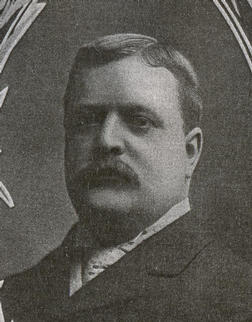
Plate 77 AC

Tapling Plate 77 BA
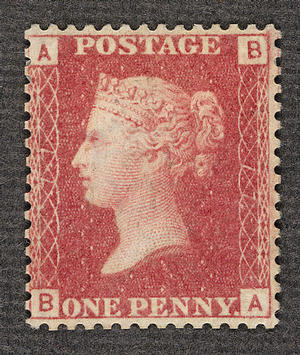
£200!. Now that would have been an excellent investment.........
Plate 77 PI

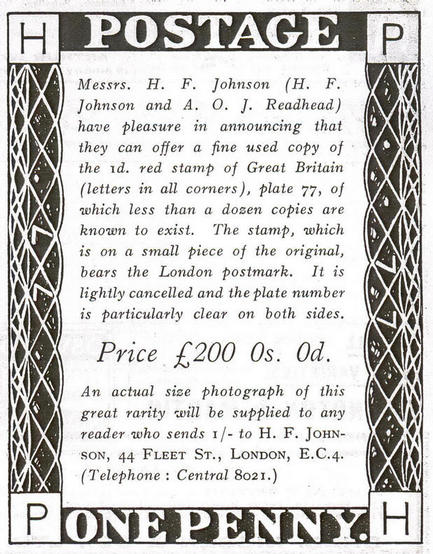
Here is the way to spot 77s as illustrated in the revised 1962 issue of The Postage Stamps of Great Britain. It's not quite as simple as that though!
Plate 77 LL

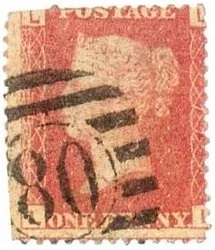
Plate 77 MI
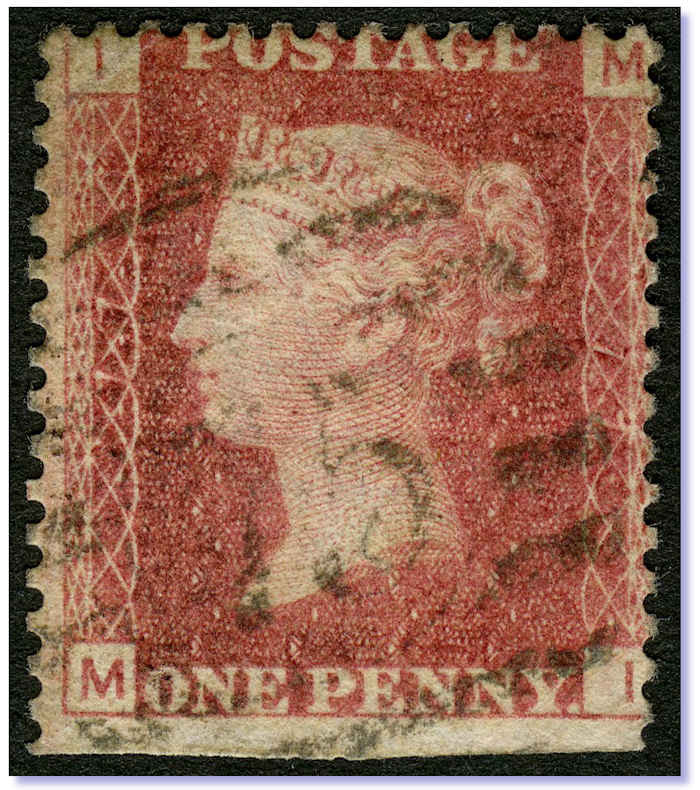
The Fletcher plate 77 PH
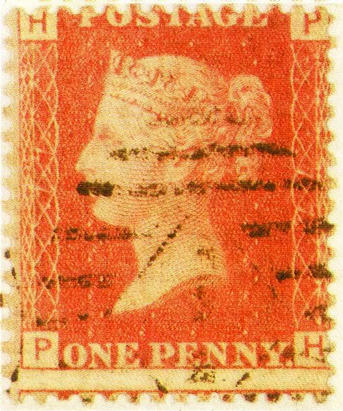
Some imposters.............
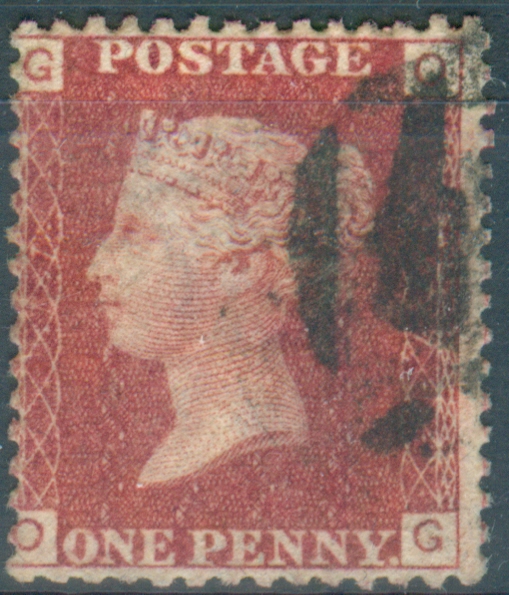
If you have a stamp that you think may be a 77 or any other unusual penny red that you would like looked at please do let me know and I'll be happy to help. I am also interested in any stamps that have been certificated as "not 77" and would be very grateful if you have an image of any such stamps or would like to sell them as I collect them!
The BBC reported as follows on 8 February 2012
Rare plate 77 Penny Red for sale by Channel Islands dealer
A dealer in the Channel Islands says it has acquired the "most valuable single stamp" it has ever had up for sale.
Stanley Gibbons said the "plate 77 Penny Red" - thought to be worth £550,000 - was one of only five used examples of the stamp ever reported.
A spokesman for the company said the Penny Reds were similar to the famous Penny Black, and although millions were printed on the so-called plate 77, the perforations did not line up correctly on some plates so were never released.
He said only a tiny handful of plate 77 Penny Reds existed, which had got into the public domain by mistake.
He added millions of collectors worldwide religiously checked every Penny Red they came across for the combination of two sevens, which he said was the "philatelic Holy Grail".
Vince Cordell, of Stanley Gibbons, said: "This example has graced some of the finest stamp collections ever formed and is not only a magnificent exhibition piece but one of the great rarities of Great Britain and world philately.
He added: "To date, four mint and five used examples have been reported, although some have not been seen for so long their authenticity is unconfirmed and often doubted."
Of the mint examples, there is one in the Royal Philatelic collection, one in the Tapling collection in the British Library, one in the Raphael collection that was stolen in 1965 and has not been seen since, and the fourth was in the Ferrary collection sold in the 1920s, but its authenticity was never confirmed and has not been seen since.
The used examples include two found in the early 20th Century that were damaged and have not been seen for more than 50 years, one in the Crocker collection that was lost in an earthquake in San Francisco in 1906, and one in the Adams collection now in the British Library.
The fifth example is the one for sale by Stanley Gibbons which it said was "realistically the only one that will ever be available on the open market".
http://www.bbc.co.uk/news/world-europe-jersey-16945226

Unfortunately for Mr Ashby, it was a plate 177!
Stamp Collectors Discussion board
|











